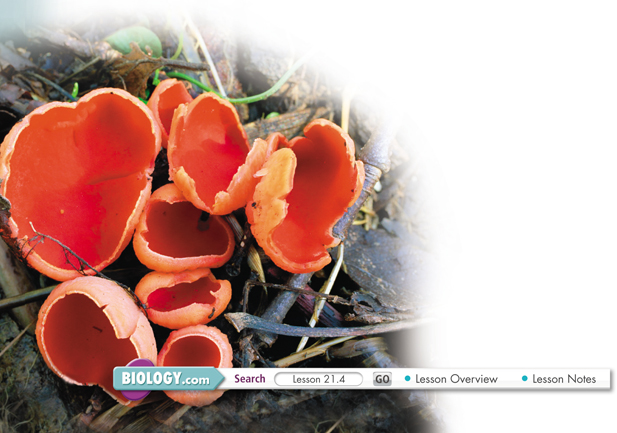21.4 Fungi
 What are the basic characteristics of fungi?
What are the basic characteristics of fungi? How do fungi affect homeostasis in other organisms and the environment?
How do fungi affect homeostasis in other organisms and the environment?
chitin • hypha • fruiting body • mycelium • lichen • mycorrhiza
Concept Map As you read, develop a concept map showing the relationships of fungi to other organisms in their environment.
THINK ABOUT IT What is the largest organism in this photo? At first glance you might pick the tree, but in fact the largest organism is a fungus. The only trace of it is the ring of mushrooms that has popped up in the grass after a brief rainstorm.
The mushrooms are just the reproductive structures of a much larger organism. Most of the mass of the fungus is underground, spanning at least the width of the ring of mushrooms, and extending more than 2 meters into the ground! Hundreds of years ago, some cultures believed these rings of mushrooms marked spots where fairies danced in circles on warm summer nights. Today people still call them fairy rings.

What Are Fungi?
 What are the basic characteristics of fungi?
What are the basic characteristics of fungi?
Like the ring of mushrooms above, many fungi grow from the ground. This once led scientists to classify them as nonphotosynthetic plants. But they aren't plants at all. Instead of carrying out photosynthesis, fungi produce powerful enzymes that digest food outside their bodies. Then they absorb the small molecules released by the enzymes. Many fungi feed by absorbing nutrients from decaying matter in the soil. Others live as parasites, absorbing nutrients from the bodies of their hosts.
Another defining characteristic of fungi is the composition of their cell walls, which contain chitin (KY tun). Chitin is a polymer made of modified sugars that is also found in the external skeletons of insects. The presence of chitin is one of several features that show fungi are more closely related to animals than to plants.  Fungi are heterotrophic eukaryotes with cell walls that contain chitin.
Fungi are heterotrophic eukaryotes with cell walls that contain chitin.

FIGURE 21–15 Scarlet Cup Fungus
Table of Contents
- Formulas and Equations
- Applying Formulas and Equations
- Mean, Median, and Mode
- Estimation
- Using Measurements in Calculations
- Effects of Measurement Errors
- Accuracy
- Precision
- Comparing Accuracy and Precision
- Significant Figures
- Calculating With Significant Figures
- Scientific Notation
- Calculating With Scientific Notation
- Dimensional Analysis
- Applying Dimensional Analysis




